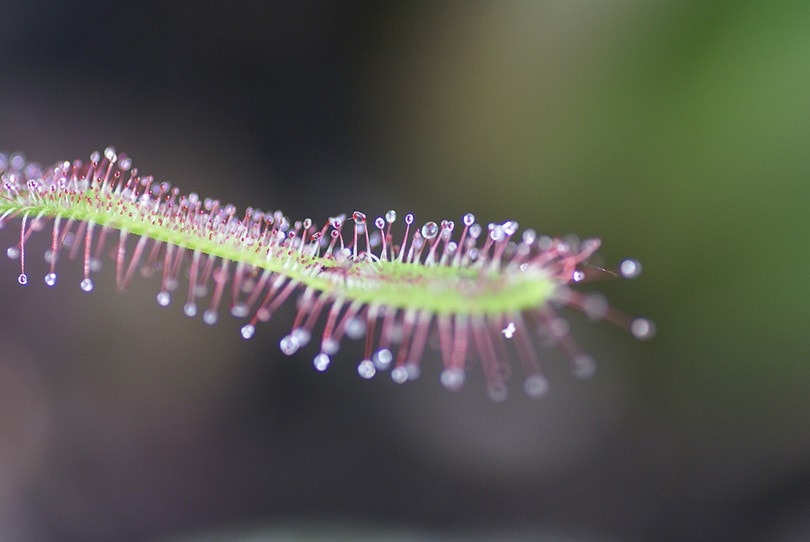Some folks grow crops to eat them, and some increase them to smell them and get pleasure from their beauty—but some folks grow plants to view them eat stuff! Carnivorous vegetation are a single of nature’s strange miracles. There are hundreds of distinct versions, and numerous of them require particular growing situations. Nevertheless, some are hardy adequate for indoor expanding. Below, we’ve set collectively a checklist of 5 of the simplest carnivorous vegetation to increase.
The 5 Easiest Carnivorous Plants to Grow
1. Cape Sundew (Drosera capensis)

| Origin: | Subtropical Region of South Africa |
| Height: | 3 inches |
| Light: | Bright, indirect |
| Water: | Rainwater, distilled |
The lengthy, slender leaves of the cape sundew have tentacle-like hairs covered in a sticky juice that draws small bugs to their doom. As soon as the insect lands, they are stuck, the leaf closes, and digestive enzymes commence the approach of breaking down the protein to feed the plant.
Since of their subtropical origins, cape sundews desire substantial humidity. Unless you reside in an incredibly humid area—and preserve it humid in your home—then a terrarium or Wardian situation are good options for supplying your tiny carnivore the moist surroundings it demands.
2. Butterworts (Pinguicula)
| Origin: | Central America |
| Height: | 1–6 inches |
| Light: | Full sun, partial shade |
| Water: | Rainwater, distilled |
Butterworts are rookie-pleasant carnivorous vegetation. Even so, owing to their choice for getting out of doors plants, they are only suited for warmer zones or potted annuals. If you stay in zones 10 or eleven, they will typically persist via the winter months and grow new rosettes every 12 months.
This carnivorous plant does not require a good deal of additional care. As extended as you plant them in the appropriate soil, they will do what they want to do to survive. A single point to observe about butterworts is that they cannot dry out. So, if there hasn’t been much rain, you have to make sure you keep their soil moist. But do so with distilled h2o as they are delicate to certain minerals and salt concentrations.
3. Pitcher Plant (Nepenthes ventrata)

| Origin: | Philippines |
| Height: | 8 inches |
| Light: | Bright, indirect |
| Water: | Rainwater, distilled |
This tropical pitcher plant is really a cross of two carnivorous vegetation indigenous to the Philippines. It is extensively offered and a common indoor plant thanks to being fairly straightforward to increase. You will usually discover this plant in a hanging basket with its “pitchers” dangling beneath carrying out their insect devouring task.
Temperature-wise, this hybrid doesn’t call for anything special, but it appreciates increased humidity simply because of its tropical origins. And, like most other carnivorous crops, it is delicate to drinking water, so rainwater is preferable, but distilled water will do the trick.
4. South African Sundew (Drocena natalensis)
| Origin: | South Africa |
| Height: | 2 inches (across) |
| Light: | full sun, direct light |
| Water: | distilled, purified |
The South African sundew stands aside from the other plants on this list. It has minimal specifications for temperature, humidity, or light-weight. It also has a extremely distinct look—like a spiky environmentally friendly starfish with white and pink spikes.
When developed in a tray, it does not demand a humid environment around two inches of distilled or purified drinking water in the tray will do the task. As much as temperature is concerned, a distribute from 40–90 degrees is acceptable. If you are in a frost-free zone, then it even thrives outside.
5. Purple Pitcher Plant (Sarracenia purpurea)

| Origin: | Humid regions of North America |
| Height: | 6–36 inches |
| Light: | Direct light |
| Water: | Rainwater, distilled |
The purple pitcher plant is one more pitcher plant variation that is suitable for indoor and beginner increasing. It is fairly hardy when it comes to temperature and can face up to winter temperatures as low as forty degrees Fahrenheit. They call for humidity earlier mentioned 50%, which is effortlessly accomplished with a humidity tray.
When it comes to watering your purple pitcher plant, they are greatest potted in a pot with drainage holes in excess of a tray. Drinking water till the tray fills up but really do not vacant it due to the fact your plant will soak up that drinking water as it needs it. The plant might go dormant over the winter months, dependent on the temperature. If it does, only drinking water it adequate to preserve the soil moist, and make certain it stays in vibrant light or direct sunlight all yr round.
No Venus Flytrap?
You could be questioning why the legendary Venus flytrap is not on this checklist. Although it is absolutely the most widespread plant one thinks about in regards to carnivorous crops, it’s not the easiest to treatment for. There are a pair of kinds that are less difficult than others. But as a general rule, the Venus flytrap is greater left to the knowledgeable carnivorous plant grower.
High Humidity Needed
Even the least demanding of these carnivorous vegetation will typically require larger humidity than the average house will have. Here are a handful of ways that you can enhance humidity for the vegetation with out always growing it for the whole residence.
- Mist plants with a spray bottle
- Put the plants in your bathroom for a humidity boost
- Put plants on a humidity tray
- Open terrarium or Wardian case
Sometimes, the concept of expanding a tropical or subtropical plant can be frustrating. It doesn’t have to be. Ideally, this list has shown that developing a tropical carnivorous plant can be a unique and rewarding knowledge with the right equipment and knowledge.
Featured Image Credit history: Hans, Pixabay
Contents
